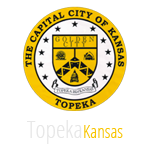The City of Topeka has announced the five finalists for the Topeka City Manager position.
Jeffrey Dingman currently serves as the Deputy City Administrator for the City of Fort Smith, Arkansas. Dingman has more than 20 years of government leadership experience and holds a Juris Doctor from the University of Kansas. He has been a Credentialed Manager through the International City/County Management Association (ICMA) since 2006. Dingman has also previously served in similar administration roles in the City of Baldwin City, Kansas and Sebastian County, Arkansas. Throughout his career, he has worked to develop short- and long-range strategic plans for communities of varying populations and has managed city budgets ranging from $13-160 million.
Alan Howze is an experienced public sector executive focused on building strong, financially sustainable communities and delivering high-quality public services. Howze has more than 20 years of professional government experience and is currently serving as the Assistant Administrator for the Unified Government of Wyandotte County and Kansas City, Kansas. He holds a Master of Business Administration from the University of Virginia and a Bachelor of Science in Economics and Anthropology from James Madison University. Throughout his career, Howze has worked in government on the local, state and federal levels and has a background in information technology and communications.
William Jones has over 24 years of local government management experience. He is currently the City Administrator for the City of Mequon, Wisconsin and previously served in similar roles for the Village of Glencoe, Illinois and the City of Highland Park, Illinois. Jones obtained his Master of Public Administration from Indiana University and is a Credentialed Manager with the International City/County Management Association, Certified Public Finance Officer from the Government Finance Officers Association, and a Certified Labor Relations Professional from the National Public Employer Labor Relations Association. In his current role, Jones has helped expand the tax base, assisted with debt issues, developed an asset management plan, revised an ethics ordinance, restructured organizational staffing, hired a new police chief, initiated a full-time staffing model for Fire and EMS and enhanced health and safety in schools via a new water source and an additional school resource officer.
Robert Perez serves as an Assistant City Manager of Infrastructure for the City of Dallas, Texas. Perez has gained over 20 years of municipal government experience while working for the City of Dallas and the City of San Antonio and holds a Doctor of Philosophy in Education with a concentration in organizational leadership, a Master of Public Administration, and a Bachelor of Arts in English with a minor in political science. Perez’s background is in Public Works, and he has published several academic articles ranging in topics from the relationship between data and infrastructure as well as innovation in local government. In his current role, Perez provides executive leadership to the City of Dallas’ Department of Public Works, Transportation, Bond and Construction Management, Equipment and Fleet Services and Building Services.
Abbe Yacoben is currently the Chief Financial Officer of Washoe County, Nevada, serving the Board of County Commissioners for the last year and a half. She has nearly 20 years of municipal government leadership experience, and has held roles in Arizona, Illinois and her home state of Maine. Yacoben holds a Master of Public Policy with a finance concentration from the University of Chicago, and she is a Certified Public Finance Officer. In her current role, Yacoben leads Washoe County Commissioners in their strategic planning process and benchmarking as well as human resources initiatives in the county. Yacoben is passionate about and skilled at leadership, teambuilding, open communication, working with different public groups and ensuring the City’s initiatives truly improve the quality of life for all residents and stakeholders.
The finalists will participate in two interview panels on Monday, April 8. One interview panel will be with the Governing Body, and the other will be with a panel of community stakeholders selected by the Mayor. The interview panels will not be open to the public, but the finalists will also attend a public meet and greet where community members are invited to attend. The meet and greet will take place on Monday, April 8 from 5:30 p.m. to 7:00 p.m. at the Hotel Topeka Emerald Ballroom located at 1717 SW Topeka Blvd. Light refreshments will be provided at the event.
Attendees will be able to provide feedback on the candidates to the Governing Body by filling out comment cards at the meet and greet.



